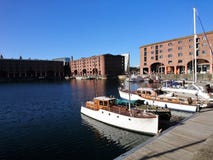Albert Dock Liverpool. This Picture Was Taken On A Lovely Very Still Day In January 2014.The Albert Dock Is A Complex Of Dock Buildings And Warehouses In Liverpool, England. Designed By Jesse Hartley And Philip Hardwick, It Was Opened In 1846, And Was The First Structure In Britain To Be Built From Cast Iron, Brick And Stone, With No Structural Wood. As A Result, It Was The First Non-Combustible Warehouse System In The World.[1]Nnat The Time Of Its Construction The Albert Dock Was Considered A Revolutionary Docking System Because Ships Were Loaded And Unloaded Directly From/To The Warehouses. Two Years After It Opened It Was Modified To Feature The World's First Hydraulic Cranes.[2] Due To Its Open Yet Secure Design, The Albert Dock Became A Popular Store For Valuable Cargoes Such As Brandy, Cotton, Tea, Silk, Tobacco, Ivory And Sugar. However, Despite The Albert Dock's Advanced Design, The Rapid Development Of Shipping Technology Meant That Within 50 Years, Larger, More Open Docks Were Required, Although It Remained A Valuable Store For Cargo.
ID 40127661 © Debchephotography | Megapixl.com
CATEGORIES
EXCLUSIVE
Your image is downloading.
Sharing is not just caring, it's also about giving credit - add this image to your page and give credit to the talented photographer who captured it.:
























































